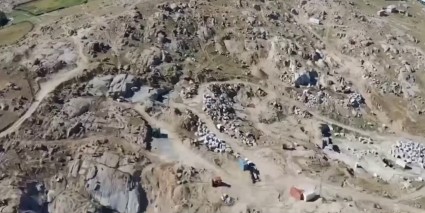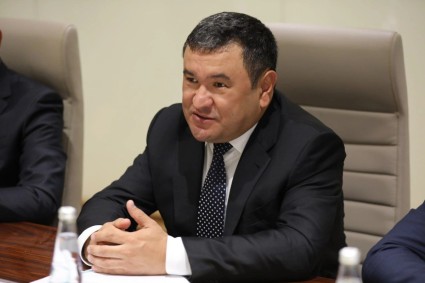The economies of Central Asia are showing strong resilience to the geopolitical adversities caused by Russia’s war on Ukraine, the European Bank for Reconstruction and Development (EBRD) reports in its latest Regional Economic Prospects today.
The EBRD is expecting the region’s GDP to grow by 4.3 per cent in 2022 and 4.9 per cent in 2023, which is an upward revision of its spring forecast.
Central Asian states, such as Kazakhstan and Turkmenistan, are enjoying record high oil and gas revenues as a result of elevated prices and increased export volumes. The Kyrgyz Republic, Tajikistan and Uzbekistan continue to receive substantial remittances from Russia, where the demand for migrant workers is growing dramatically. The region is also experiencing very strong growth in real wages and public revenues.
Many countries in Central Asia are benefiting from Russian households seeking to obtain international payment cards and place their foreign currency savings in Central Asia. Thousands of Russian speakers (from Belarus, Russia and Ukraine) are relocating and moving their businesses to Central Asia, taking advantage of special economic zones, such as Uzbekistan’s IT Park, created to capture digital nomads and exporters of IT services.
As a result, the region’s capital cities are experiencing a real estate boom, as well as strong expansion in hospitality and catering. Regional economies, such as Kazakhstan and the Kyrgyz Republic, are also benefiting from re-exports to Russia of computers, consumer electronics and home appliances, spare auto parts, and electrical and electronic components, often facilitated by small shuttle traders.
Regional currencies collapsed after Russia’s invasion of Ukraine but they have largely reverted to their pre-war values. Financial sector regulators brought in tougher compliance measures to reduce the risk of further collapses from any secondary sanctions.
The most urgent challenge all Central Asian economies are facing today is inflation and, in the slightly longer term, debt service costs. CPI inflation is in the 10-16 per cent range, way above the target corridors, which jeopardises the wellbeing of many households and puts structural reforms and fiscal consolidation measures at risk.
Uzbekistan achieved very strong growth of 7.4 per cent in 2021 and continues to perform exceptionally well. Growth is supported by a surge in remittances from Russia, which were up by 96 per cent in the first half of 2022 compared with the same period in 2021. On the negative side, CPI inflation reached 12.3 per cent in July 2022 on the back of rising food and commodity prices.
Overall, Uzbekistan continues to enjoy very strong economic growth driven by a large and industrious labour force, a sizeable domestic market, diversified manufacturing capacity and progress with market-oriented reforms. The Bank forecasts the economy to grow at 5.5 per cent in 2022, and 6.5 per cent in 2023.
Despite significant exposure to Russia, Kazakhstan’s economy grew 3.4 per cent year-on-year in the first half of 2022. The country’s oil exports reached US$ 42.2 billion, a level not seen since 2014. Elevated prices were the main contributor to this, but volumes increased as well by almost 10 per cent. Significant downside risks relate to possible interruptions of oil transit through Russia.
Banks in Kazakhstan are enjoying a steady inflow of new clients from sanctioned countries such as Russia and Belarus. The main challenges for Kazakhstan are the implementation of fiscal consolidation measures and the delivery of its ambitious reform agenda. Overall, the economy is expected to post 3.0 per cent growth in 2022, and 3.5 per cent in 2023.
The strong Russian ruble and Russia’s high demand for imported labour resulted in remittances to the Kyrgyz Republic increasing by 11.0 per cent in the first half of 2022. They supported domestic demand and enabled growth in industrial production, hospitality, trade and logistics. The country leads the EBRD regions in real wage growth, which is driven by salary increases for public sector employees and strong demand for qualified labour.
The re-export of Chinese goods to Russia has become a major business activity for small Kyrgyz companies and individuals. The government’s success in settling the long-standing conflict over the Kumtor gold mine has helped to restore foreign investor confidence, and the inflow of foreign direct investment (FDI) almost doubled in January-June 2022, to US$ 628 million. The EBRD is expecting further FDI into major hydropower and railway projects in the coming years.
The country’s economy is likely to benefit from increased re-export opportunities, money transfers and the relocation of Russian companies and individuals. GDP growth is forecast at 7.0 per cent for both 2022 and 2023.
Reduced gas supplies from Russia and rising inflation worldwide will further slow growth in the EBRD regions next year. Therefore, GDP growth across the regions is forecast at 3.0 per cent, a downward revision of 1.7 per cent compared with the Bank’s previous report in May. This projection is subject to major downside risks should Russia’s war on Ukraine escalate or the volume of its gas exports reduce still further.
However, an upward revision to predicted growth this year is likely to deliver a gentler slowdown in real terms, with output next year a mere 0.2 per cent lower than forecast earlier this summer.
Output in the EBRD regions is now expected to grow by 2.4 per cent in 2022 after consumers in emerging Europe went on a post-pandemic spending spree in the first half of the year.
This temporarily boosted consumption despite a fall in real wages and led to a sharp widening of current account deficits in central Europe.
EBRD Chief Economist Beata Javorcik said: “These are very worrying times for the EBRD regions and many advanced economies. As we head towards winter the economic cost of Russia’s war on Ukraine is growing clearer with every day that passes.
“Inflation may not have peaked in the EBRD regions, as in many countries the increase in producer costs and high natural gas prices have not been fully reflected in consumer prices yet.”
The new Regional Economic Prospects report titled “A cold winter ahead?” provides a stark portrait of the impact of the war on the regions’ energy markets, inflation and economies.
Since late February 2022 gas prices in Europe have averaged around 2.5 times their 2021 level (in inflation-adjusted terms). For many countries in the EBRD regions higher gas prices imply increases in gas import bills equivalent to between 4 and 5 per cent of GDP, as economies are highly dependent on gas in their energy mix.
Gas accounts for the bulk of derived heat production. In some economies, gas is also an important source of electricity production. Even where electricity is not directly derived from gas, electricity and gas prices tend to move in parallel.
Average inflation in the EBRD regions reached 16.5 per cent in July, a level last seen in 1998.
Energy and food usually account for a higher share of consumption of poorer households, who are experiencing even higher effective rates of inflation. Real wage growth has turned negative on average, with greatest falls in real incomes in south-eastern Europe.
But there are still wide variations in the impact of the war across different regions and countries.
Russia’s war on Ukraine will cause the latter’s economy to shrink by 30 per cent this year, the Bank forecasts, a projection unchanged since May.
For 2023 the EBRD has lowered its forecast to a rebound of just 8 per cent from the more robust 25 per cent growth foreseen in the last report. The expectation then was that substantial recovery work would already be under way next year.












